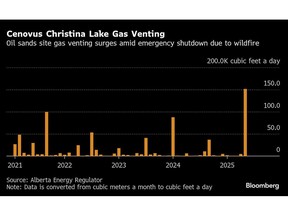
Article content
(Bloomberg) — Cenovus Energy Inc.’s Christina Lake oil-sands site vented the most natural gas in more than four years into the atmosphere when a wildfire forced an emergency shutdown of the facility in May.
THIS CONTENT IS RESERVED FOR SUBSCRIBERS ONLY
Subscribe now to read the latest news in your city and across Canada.
- Exclusive articles from Barbara Shecter, Joe O'Connor, Gabriel Friedman, and others.
- Daily content from Financial Times, the world's leading global business publication.
- Unlimited online access to read articles from Financial Post, National Post and 15 news sites across Canada with one account.
- National Post ePaper, an electronic replica of the print edition to view on any device, share and comment on.
- Daily puzzles, including the New York Times Crossword.
SUBSCRIBE TO UNLOCK MORE ARTICLES
Subscribe now to read the latest news in your city and across Canada.
- Exclusive articles from Barbara Shecter, Joe O'Connor, Gabriel Friedman and others.
- Daily content from Financial Times, the world's leading global business publication.
- Unlimited online access to read articles from Financial Post, National Post and 15 news sites across Canada with one account.
- National Post ePaper, an electronic replica of the print edition to view on any device, share and comment on.
- Daily puzzles, including the New York Times Crossword.
REGISTER / SIGN IN TO UNLOCK MORE ARTICLES
Create an account or sign in to continue with your reading experience.
- Access articles from across Canada with one account.
- Share your thoughts and join the conversation in the comments.
- Enjoy additional articles per month.
- Get email updates from your favourite authors.
THIS ARTICLE IS FREE TO READ REGISTER TO UNLOCK.
Create an account or sign in to continue with your reading experience.
- Access articles from across Canada with one account
- Share your thoughts and join the conversation in the comments
- Enjoy additional articles per month
- Get email updates from your favourite authors
Sign In or Create an Account
or
Article content
Christina Lake released the equivalent of 151,511 cubic feet a day of climate-warming gas in May, up from less than 5,000 cubic feet a day in April, Alberta Energy Regulator data show. The amount vented was the most for any month since January 2021. The monthly increase in venting was the most for any facility in Alberta and only eight other sites, all of which primarily produce gas rather than oil, released more in total.
Article content
Article content
Article content
Cenovus along with other oil-sands producers including Canadian Natural Resources Ltd. and MEG Energy Corp. curtailed the equivalent of about 350,000 barrels a day of production in late May and early June as a wildfire threatened well sites, prompting the companies to evacuate workers. The Christina Lake site produces about 230,000 barrels a day.
Article content
By signing up you consent to receive the above newsletter from Postmedia Network Inc.
Article content
“Most of the venting in May was directly related to the safe shutdown of the Christina Lake facility at the end of the month due to the wildfire in the area,” the company said in an email. “In an emergency shutdown, we can’t burn or use that gas for operations, which leaves venting as the only option.”
Article content
The sudden methane release caused by the shutdown of one of Canada’s largest oil-producing sites illustrates just one negative impact of the wildfires that erupt each summer in Canada, which themselves emit massive amounts of carbon dioxide into the atmosphere. Extreme forest fires in 2023 emitted about 640 million metric tons of carbon, according to National Aeronautics and Space Administration, equal to the annual fossil fuel emissions of a large industrialized nation. Methane concentration in the atmosphere has more than doubled over 200 years and is estimated to account for 20% to 30% of global warming since the Industrial Revolution.
Article content
Advertisement 1

.jpg) 8 hours ago
2
8 hours ago
2
 English (US)
English (US)